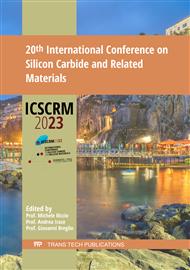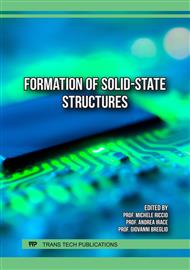[5]
Conclusions In this paper, finishing methods to recover the surface of thinned 4H-SiC substrates have been compared. Dry polishing (DP), chemical mechanical polishing (CMP), bulk and laser thermal annealing processes have been accounted and systematic investigations on wafer warpage, backside SiC wafer morphology have been conducted. The mechanical reliability at a die level has also been examined. Collected data reveal the efficiency of material removal-based finishing methods such as DP and CMP in restoring wafer warpage and surface quality to the original, not ground, level. Nevertheless, a certain value of surface roughness is necessary to promote at the final stage of the device fabrication flow, when SiC wafer is thinned to the final device operating thickness, the back side ohmic contact formation and the back side metal adhesion. In this respect, finishing methods based on material rearrangement, i.e., the attempt to restore the wafer warpage and surface quality by thermal processing used in this work, proved to be more efficient. In case of bulk thermal annealing, a high enough thermal budget is supplied for prolonged time in a way to guarantee atomic movement and rearrangement. We specifically found that at a bulk annealing temperature higher than 1500 °C, atoms in the damaged region rearrange towards a minimum free energy producing an irregular, terraced surface. The surface features can be eventually tuned by properly adjusting the thermal process in terms of maximum temperature and annealing time. Besides, the wafer warpage in this case is close to the original, before grinding process. The bulk thermal treatment hence demonstrated to be a good compromise between surface roughness and stress relief. However, the high temperature involved is not compliant with the device fabrication process flow. In case of laser annealing, in a significant part of the fluence range under investigation, the process melts the first 80 nm of the 4H-SiC monocrystal and causes surface rearrangement in a three-layer configuration with a reconstructed SiC at the interface with monocrystalline SiC, followed by a thin Si and C layers. The surface morphology keeps grinding wheel marks still visible; the wafer warpage value is almost unchanged with respect to the value we found on as ground wafer. This means that the process is not acting as a stress relief for damage induced by grinding. Moreover, cracks form, due to fast thermal changes between adjacent regions. The flexural stress of laser treated sample is comparable with the corresponding values found for samples whose backside surface has been treated, after back grinding, with DP or CMP. From a mechanical point of view, the laser annealing process, does not impact die reliability, despite the presence of cracks, representing a suitable back finishing process especially in the optic of its use in backside ohmic contact formation [[] P. Badalà, S. Rascunà, B. Cafra, A. Bassi, E. Smecca, M. Zimbone, C. Bongiorno, M.Calabretta, F. La Via, F. Roccaforte, M. Saggio, G. Franco, A. Messina, A. La Magna, A. Alberti, Ni/4H-SiC interaction and silicide formation under excimer laser annealing for ohmic contact. Materialia, 9, 2020, 100528. ] Those findings address the research direction in a way to suitably tailor the laser process to give valid solution as a finishing method for thinned 4H-SiC wafers. References
Google Scholar



